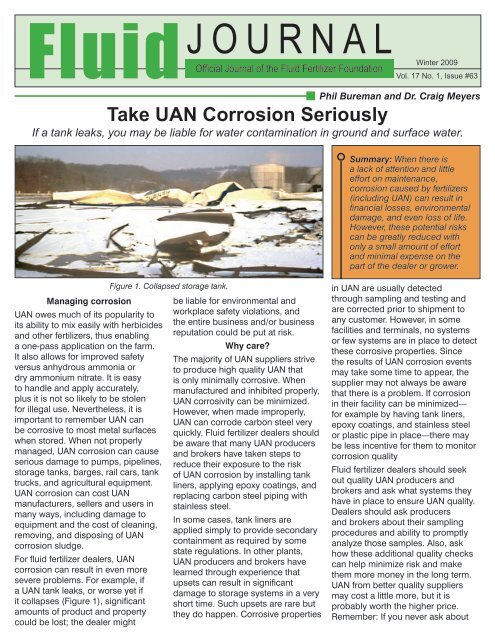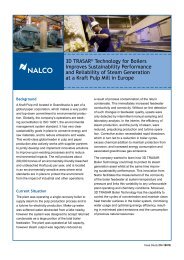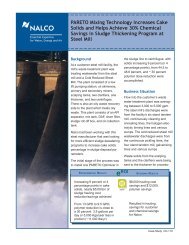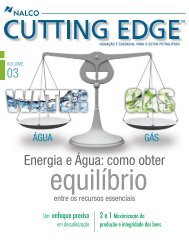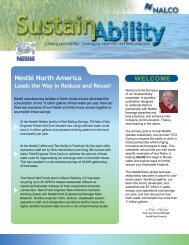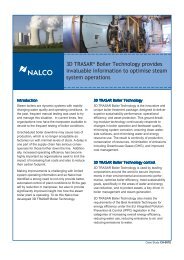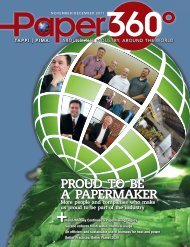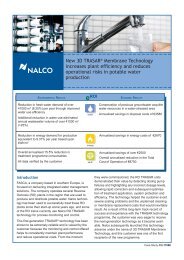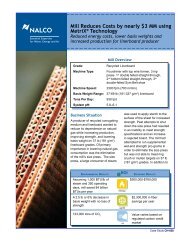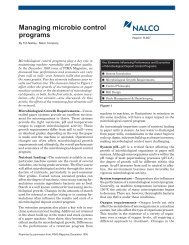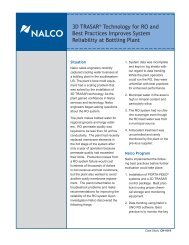Take UAN Corrosion Seriously - Nalco
Take UAN Corrosion Seriously - Nalco
Take UAN Corrosion Seriously - Nalco
You also want an ePaper? Increase the reach of your titles
YUMPU automatically turns print PDFs into web optimized ePapers that Google loves.
Fluid J O U R N A L Winter 2009<br />
Official Journal of the Fluid Fertilizer Foundation<br />
Vol. 17 No. 1, Issue #63<br />
Phil Bureman and Dr. Craig Meyers<br />
<strong>Take</strong> <strong>UAN</strong> <strong>Corrosion</strong> <strong>Seriously</strong><br />
If a tank leaks, you may be liable for water contamination in ground and surface water.<br />
Managing corrosion<br />
<strong>UAN</strong> owes much of its popularity to<br />
its ability to mix easily with herbicides<br />
and other fertilizers, thus enabling<br />
a one-pass application on the farm.<br />
It also allows for improved safety<br />
versus anhydrous ammonia or<br />
dry ammonium nitrate. It is easy<br />
to handle and apply accurately,<br />
plus it is not so likely to be stolen<br />
for illegal use. Nevertheless, it is<br />
important to remember <strong>UAN</strong> can<br />
be corrosive to most metal surfaces<br />
when stored. When not properly<br />
managed, <strong>UAN</strong> corrosion can cause<br />
serious damage to pumps, pipelines,<br />
storage tanks, barges, rail cars, tank<br />
trucks, and agricultural equipment.<br />
<strong>UAN</strong> corrosion can cost <strong>UAN</strong><br />
manufacturers, sellers and users in<br />
many ways, including damage to<br />
equipment and the cost of cleaning,<br />
removing, and disposing of <strong>UAN</strong><br />
corrosion sludge.<br />
For fluid fertilizer dealers, <strong>UAN</strong><br />
corrosion can result in even more<br />
severe problems. For example, if<br />
a <strong>UAN</strong> tank leaks, or worse yet if<br />
it collapses (Figure 1), significant<br />
amounts of product and property<br />
could be lost; the dealer might<br />
Figure 1. Collapsed storage tank.<br />
be liable for environmental and<br />
workplace safety violations, and<br />
the entire business and/or business<br />
reputation could be put at risk.<br />
Why care?<br />
The majority of <strong>UAN</strong> suppliers strive<br />
to produce high quality <strong>UAN</strong> that<br />
is only minimally corrosive. When<br />
manufactured and inhibited properly,<br />
<strong>UAN</strong> corrosivity can be minimized.<br />
However, when made improperly,<br />
<strong>UAN</strong> can corrode carbon steel very<br />
quickly. Fluid fertilizer dealers should<br />
be aware that many <strong>UAN</strong> producers<br />
and brokers have taken steps to<br />
reduce their exposure to the risk<br />
of <strong>UAN</strong> corrosion by installing tank<br />
liners, applying epoxy coatings, and<br />
replacing carbon steel piping with<br />
stainless steel.<br />
In some cases, tank liners are<br />
applied simply to provide secondary<br />
containment as required by some<br />
state regulations. In other plants,<br />
<strong>UAN</strong> producers and brokers have<br />
learned through experience that<br />
upsets can result in significant<br />
damage to storage systems in a very<br />
short time. Such upsets are rare but<br />
they do happen. Corrosive properties<br />
Summary: When there is<br />
a lack of attention and little<br />
effort on maintenance,<br />
corrosion caused by fertilizers<br />
(including <strong>UAN</strong>) can result in<br />
financial losses, environmental<br />
damage, and even loss of life.<br />
However, these potential risks<br />
can be greatly reduced with<br />
only a small amount of effort<br />
and minimal expense on the<br />
part of the dealer or grower.<br />
in <strong>UAN</strong> are usually detected<br />
through sampling and testing and<br />
are corrected prior to shipment to<br />
any customer. However, in some<br />
facilities and terminals, no systems<br />
or few systems are in place to detect<br />
these corrosive properties. Since<br />
the results of <strong>UAN</strong> corrosion events<br />
may take some time to appear, the<br />
supplier may not always be aware<br />
that there is a problem. If corrosion<br />
in their facility can be minimized--for<br />
example by having tank liners,<br />
epoxy coatings, and stainless steel<br />
or plastic pipe in place---there may<br />
be less incentive for them to monitor<br />
corrosion quality<br />
Fluid fertilizer dealers should seek<br />
out quality <strong>UAN</strong> producers and<br />
brokers and ask what systems they<br />
have in place to ensure <strong>UAN</strong> quality.<br />
Dealers should ask producers<br />
and brokers about their sampling<br />
procedures and ability to promptly<br />
analyze those samples. Also, ask<br />
how these additional quality checks<br />
can help minimize risk and make<br />
them more money in the long term.<br />
<strong>UAN</strong> from better quality suppliers<br />
may cost a little more, but it is<br />
probably worth the higher price.<br />
Remember: If you never ask about
anything except nitrogen content and<br />
price, your supplier probably won’t<br />
care about anything else either.<br />
On the other hand, fluid fertilizer<br />
dealers and <strong>UAN</strong> bulk tank owners<br />
may not want to depend solely upon<br />
their <strong>UAN</strong> supplier to manage the<br />
corrosion that could occur in their<br />
equipment. The potential for <strong>UAN</strong><br />
corrosivity can vary greatly from<br />
producer to producer, plant-to-plant,<br />
and even day-to-day in the same<br />
plant or terminal.<br />
Before we discuss more about<br />
how to evaluate and minimize<br />
the corrosive quality of <strong>UAN</strong> you<br />
purchase, we must first understand<br />
more about why <strong>UAN</strong> is corrosive<br />
and the key corrosion mechanisms<br />
that occur when <strong>UAN</strong> is stored.<br />
Excess ammonia<br />
Of the components that make up<br />
<strong>UAN</strong> (urea, ammonium nitrate, water,<br />
and a small amount of ammonia),<br />
ammonium nitrate (AN) is the<br />
more corrosive component. AN’s<br />
corrosive affect is buffered by the<br />
small amount of “excess” ammonia<br />
present; as little as 0.01 percent (100<br />
ppm) to as much as 0.20 percent<br />
(2,000 ppm). Ammonia itself is not a<br />
corrosion inhibitor. But without this<br />
small amount of excess ammonia,<br />
<strong>UAN</strong> becomes extremely acidic<br />
and corrosion inhibitors cannot be<br />
applied cost effectively. One might<br />
wonder why extra ammonia is not<br />
always added to the <strong>UAN</strong> solution.<br />
It generally is not an issue of cost.<br />
Instead, excess ammonia content is<br />
usually limited by plant design and<br />
customer preference. Some <strong>UAN</strong><br />
buyers prefer high ammonia levels in<br />
the <strong>UAN</strong> they purchase because their<br />
customers prefer that the <strong>UAN</strong> have a<br />
strong ammonia odor. Other buyers<br />
worry about odor complaints from<br />
neighbors if ammonia levels are too<br />
high during application. In addition,<br />
very high ammonia levels could be a<br />
safety hazard for personnel loading<br />
and unloading <strong>UAN</strong>. Furthermore,<br />
some herbicides and other tank mix<br />
products are sensitive to having too<br />
much ammonia in the <strong>UAN</strong>. With<br />
either preference, corrosion can be<br />
controlled as long as the ammonia<br />
Figure 2. Example of how “thin <strong>UAN</strong> film corrosion” can occur.<br />
stays in the <strong>UAN</strong> at adequate levels.<br />
The problem is there are many ways<br />
in which ammonia can be reduced<br />
to levels that no longer provide the<br />
buffering required.<br />
For example, consider a rail car<br />
full of <strong>UAN</strong>, as depicted in Figure<br />
2. When full, the ammonia quickly<br />
saturates the small vapor space<br />
above the liquid level in the car. Even<br />
when warm, no significant amount of<br />
ammonia is lost, so the <strong>UAN</strong> remains<br />
fairly non-corrosive. However, upon<br />
arrival at a customer site, when<br />
the tanker is emptied, a thin film of<br />
<strong>UAN</strong> is left on the tank wall. At the<br />
same time, fresh air (that contains<br />
no ammonia at all) is sucked into<br />
the tank. When this happens, the<br />
ammonia levels in the vapor space<br />
must be reestablished. The only<br />
source of ammonia is the “thin film”<br />
left on the tank wall. If there is very<br />
little ammonia available, such as<br />
when excess ammonia levels in the<br />
bulk <strong>UAN</strong> are less than 100 ppm<br />
to begin with, the corrosivity of the<br />
small amount of <strong>UAN</strong> remaining<br />
on the tank walls can increase<br />
dramatically.<br />
Surface corrosion<br />
As <strong>UAN</strong> levels in storage tanks<br />
drop during the season, this same<br />
corrosive “thin film” is formed on<br />
the vertical wall as fresh air comes<br />
into the <strong>UAN</strong> storage tank. For<br />
this reason, fluid fertilizer dealers<br />
should ask about the typical<br />
excess ammonia provided by their<br />
<strong>UAN</strong> supplier. If there is a need to<br />
purchase a low ammonia product,<br />
the dealer should be aware that<br />
other steps may need to be taken to<br />
help minimize the impact of this low<br />
ammonia level.<br />
The type of corrosion produced by<br />
low ammonia levels is called “surface<br />
corrosion.” The good news is that<br />
surface corrosion initially is not very<br />
damaging to the steel. However, it<br />
does contribute to other problems.<br />
In a simple demonstration, that can<br />
be done in one’s own backyard,<br />
a steel corrosion coupon was put<br />
inside a well-sealed glass jar along<br />
with just enough <strong>UAN</strong> 32 to barely<br />
cover most of the coupon. In this<br />
example, an old coupon was used<br />
that happened to have a small<br />
corrosion spot on one side. The jar<br />
was sealed and left in the sun for 7<br />
days (Figure 3) and during that time<br />
there was no sign of new corrosion.<br />
The jar was then opened to the air for<br />
about 3 hours and resealed and left<br />
overnight. The following morning, it<br />
was noted that severe corrosion had<br />
developed on the coupon (Figure 4).<br />
However, this generalized surface<br />
corrosion was not very damaging<br />
and was easily wiped off with a paper
towel. The amount of metal loss was<br />
small enough that even the original<br />
corrosion spot remained on the<br />
coupon (Figure 5).<br />
Sludge<br />
It has been determined that opening<br />
the jar resulted in the release of<br />
the ammonia from the <strong>UAN</strong>, which<br />
caused the corrosion that occurred<br />
on the surface of the coupon. The<br />
“Key <strong>Take</strong> Away” from this example<br />
is that although surface corrosion<br />
may not be very damaging, it does<br />
generate a large amount of corrosion<br />
sludge, and this sludge winds up<br />
on the tank floor! The reason this is<br />
important is that the generation of<br />
surface corrosion sludge leads to<br />
a major <strong>UAN</strong> corrosion mechanism<br />
called “under deposit corrosion.”<br />
The chemistry that occurs with under<br />
deposit corrosion is complicated<br />
and a rigorous description is beyond<br />
the scope of this article. In brief,<br />
corrosion sludge prevents the normal<br />
flow of ions in the <strong>UAN</strong> solution and<br />
results in the formation of “pockets<br />
Figure 3. Sealed jar left in sun for 7 days.<br />
of corrosive ions” under the sludge<br />
on the tank floor. The buildup of<br />
corrosion sludge can also prevent<br />
corrosion inhibitors from accessing<br />
the steel under the sludge. The net<br />
result is the deep pitting that usually<br />
occurs on <strong>UAN</strong> tank bottoms. It is not<br />
unusual to see <strong>UAN</strong> pits as deep as<br />
a quarter inch develop in as little as<br />
5 years when preventive measures<br />
are not taken. Examples of <strong>UAN</strong><br />
sludge buildup and the resulting<br />
pitting corrosion are shown below in<br />
Figures 6, 7, 8 and 9.<br />
Managing <strong>UAN</strong> corrosion<br />
Fluid fertilizer dealers who handle<br />
Figure 4. Severe corrosion developed on coupon after loss of ammonia.<br />
in steel piping. Blowing them<br />
clear with air just flashes off<br />
any remaining ammonia buffer,<br />
leaving thin films of acidic<br />
<strong>UAN</strong> on the pipe wall. Instead,<br />
consider a flush with aqua<br />
ammonia or, where practical,<br />
install corrosion- resistant pipe<br />
such as plastic or stainless steel.<br />
Figure 5. Surface corrosion initially<br />
results in minimal damage.<br />
<strong>UAN</strong> should assume a more active<br />
role managing <strong>UAN</strong> corrosion. There<br />
are mechanical, operational, and<br />
chemical means to do so, and all<br />
three areas should be considered at<br />
any <strong>UAN</strong> handling facility.<br />
Mechanical<br />
• Drain and clean <strong>UAN</strong> storage<br />
tanks at least every two years.<br />
This will remove the surface<br />
corrosion sludge that leads to the<br />
more damaging “under deposit<br />
or pitting type corrosion.”<br />
• Never leave small puddles or<br />
“heels” of <strong>UAN</strong> in storage tanks<br />
for long periods of time. As in the<br />
rail car example cited above, this<br />
<strong>UAN</strong> can easily be stripped of<br />
the buffering ammonia and this<br />
results in acidity in the <strong>UAN</strong> and<br />
severe corrosion.<br />
• Avoid leaving puddles of <strong>UAN</strong><br />
• Secure the dome covers on<br />
all empty tanks or tankers that<br />
hold or transport <strong>UAN</strong>. This is<br />
particularly important for trucks<br />
and rail cars because it helps<br />
prevent the loss of excess<br />
ammonia. Dealers who carelessly<br />
leave this equipment open to<br />
the atmosphere increase the<br />
cost that all dealers pay for <strong>UAN</strong><br />
transport and storage.<br />
• Install a recirculation header in<br />
storage tanks. <strong>Corrosion</strong> sludge<br />
is bad, but sludge that does<br />
not move is even worse, as this<br />
Figure 6. <strong>UAN</strong> tank sludge.
allows for the buildup of “pockets<br />
of corrosive ions” under the<br />
corrosion sludge. Many <strong>UAN</strong><br />
producers now have adopted<br />
a best practice of installing an<br />
inlet recirculation pipe across<br />
the entire diameter of their tank<br />
bottom. This header pipe has<br />
several outlet spouts that point<br />
toward the floor at a 45 o angle.<br />
Recirculation of the <strong>UAN</strong> allows<br />
Figure 7. Pitting under <strong>UAN</strong> tank sludge.<br />
Figure 8. <strong>UAN</strong> rail car sludge.<br />
tank sludge to keep moving<br />
across the tank bottom. This<br />
helps to greatly reduce pitting<br />
corrosion.<br />
• Some new tank builders are now<br />
recommending installation of a<br />
sloped tank bottom with a center<br />
outlet. This design is great for<br />
corrosion prevention, as sludge is<br />
constantly removed from the tank<br />
so buildup is always minimal.<br />
• Consider installing a tank liner<br />
or applying a protective coating.<br />
Evaluate these options carefully,<br />
as these components can also<br />
fail, potentially resulting in an<br />
even larger problem.<br />
Operational<br />
• Check the pH of incoming<br />
<strong>UAN</strong>. Measurement of pH is a<br />
good indication of how much<br />
excess ammonia is contained<br />
in the <strong>UAN</strong>. Most producers<br />
ship product with a pH above<br />
7.0. A pH as low as 6.5 is quite<br />
acceptable, but much below<br />
that there is a risk of stressing<br />
all the corrosion management<br />
systems. Discuss with your<br />
supplier a desire to receive<br />
product with a pH no lower than<br />
6.5. <strong>UAN</strong> purchasers can check<br />
the pH of incoming <strong>UAN</strong> with<br />
something as inexpensive as pH<br />
paper tape (less than $50), or<br />
consider the purchase of a pH<br />
meter (less than $500). This is<br />
highly recommended if you are<br />
purchasing imported product,<br />
which has been known to lose<br />
Figure 9. Pitting under <strong>UAN</strong> rail car sludge.<br />
excess ammonia during the long<br />
transport time.<br />
• If available, ask the supplier to<br />
include excess ammonia levels<br />
on the Certificate of Analysis<br />
for each load. Excess ammonia<br />
should be no less than 0.010<br />
weight percent (100 ppm), and<br />
preferably should be at least<br />
0.020 to 0.050 weight percent<br />
(200-500 ppm).<br />
• Another important quality of<br />
the <strong>UAN</strong> is known as the AN/<br />
Urea Ratio. This is a simple<br />
mathematical calculation of the
weight percent of ammonium<br />
nitrate divided by the weight<br />
percent of urea. In <strong>UAN</strong> 32, this<br />
ratio is typically something like<br />
45%/35% = 1.28 AN/Urea Ratio.<br />
The AN/Urea Ratio is important<br />
because it greatly affects the<br />
temperature at which <strong>UAN</strong> starts<br />
to salt out. <strong>UAN</strong> 32 typically<br />
has a salt-out temperature of<br />
about 30 o F. But this is only true<br />
at the optimal AN/Urea ratio<br />
range of about 1.20 to 1.40. At<br />
ratios above 1.6 or below 1.0,<br />
<strong>UAN</strong> 32 could start to salt out<br />
at temperatures above 45 o F or<br />
higher. This is important because<br />
salt-out means lost nitrogen<br />
content. In addition, both AN and<br />
urea salts form very aggressive<br />
corrosion cells, so they are not<br />
a good thing to have sitting at<br />
the bottom of a tank (it’s like<br />
leaving rock salt on the driveway<br />
at home). Lastly, both AN and<br />
urea salts have a negative heat<br />
of solution. This means that large<br />
amounts of heat are needed to<br />
get these salts back into solution.<br />
This may not be a problem when<br />
purchasing <strong>UAN</strong> in the spring,<br />
when ambient temperatures are<br />
already well above 50 o F, and the<br />
<strong>UAN</strong> is to be applied right away.<br />
But the AN/Urea Ratio should<br />
be considered if one plans to<br />
store <strong>UAN</strong> 32 during cold winter<br />
months. There is no easy way for<br />
<strong>UAN</strong> purchasers to measure this<br />
parameter, but local suppliers<br />
should be able to give customers<br />
some typical values, or possibly<br />
include this measurement on<br />
the Certificate of Analysis, if<br />
requested.<br />
• Try to store only <strong>UAN</strong> 32.<br />
Contrary to what many believe,<br />
<strong>UAN</strong> 28 is more corrosive than<br />
<strong>UAN</strong> 32. Consider purchasing<br />
and storing only <strong>UAN</strong> 32, and<br />
then if needed, dilute it with water<br />
to 28% just prior to application.<br />
• Lastly, purchasing quality<br />
<strong>UAN</strong> from a trusted source is<br />
probably worth a higher price.<br />
As detailed above, purchasers<br />
should monitor the product they<br />
receive and ask questions about<br />
the quality of the <strong>UAN</strong> being<br />
purchased. If suppliers can’t tell<br />
buyers about the quality of the<br />
<strong>UAN</strong> being offered, they may not<br />
be monitoring it themselves.<br />
Chemical<br />
• Fluid fertilizer dealers should<br />
ask what type and how much<br />
corrosion inhibitor is being used<br />
in the <strong>UAN</strong> they purchase. It<br />
might be possible to request<br />
the treatment rate and brand of<br />
corrosion inhibitor be included on<br />
the Certificate of Analysis.<br />
• If purchasing <strong>UAN</strong> from multiple<br />
suppliers or sites, it is possible<br />
to end up with <strong>UAN</strong> containing<br />
multiple inhibitors in your storage<br />
tanks. Although compatibility<br />
among different inhibitors is not<br />
an issue, these different inhibitors<br />
(now diluted) may not be as<br />
effective together as they were by<br />
themselves at full strength.<br />
• Fluid fertilizer dealers should<br />
consider purchasing and<br />
applying their own corrosion<br />
inhibitor programs. <strong>Corrosion</strong><br />
inhibitor chemicals are<br />
inexpensive, compared to the<br />
cost of <strong>UAN</strong>. <strong>Corrosion</strong> inhibitor<br />
programs typically cost $0.60-<br />
$0.70 per ton of treated <strong>UAN</strong><br />
when purchasing in the small<br />
amounts likely to be needed by<br />
fluid fertilizer dealers. This cost<br />
could be much less if the inhibitor<br />
choice is matched to the one<br />
used by the <strong>UAN</strong> supplier. Most<br />
<strong>UAN</strong> corrosion inhibitors are easy<br />
to apply and safe to use. There<br />
are some products, however,<br />
which themselves are quite acidic<br />
and are inherently hazardous<br />
to handle and store. Be sure<br />
to discuss this question with<br />
potential inhibitor vendors.<br />
• There are two basic types of <strong>UAN</strong><br />
corrosion inhibitors. “Filmer”<br />
type inhibitors form a protective<br />
film on steel. “Passivator” type<br />
inhibitors actually combine with<br />
the corrosion products when<br />
corrosion is initiated and stop<br />
corrosion by “sealing off” the<br />
corrosion cell. Both types have<br />
advantages and disadvantages<br />
and when applied correctly<br />
either type will greatly reduce<br />
<strong>UAN</strong> corrosion. Some inhibitor<br />
formulations offer additional<br />
features such as sludge<br />
dispersants, metal chelants,<br />
anti-foam additives and tracer<br />
compounds. A sales engineer,<br />
educated in <strong>UAN</strong> corrosion<br />
inhibitors, can help you decide<br />
which type is best for your <strong>UAN</strong>.<br />
Phil Bureman is <strong>Nalco</strong>’s<br />
technical consultant for<br />
Chemicals and Biofuels and<br />
lives in Olathe, KS; pebureman@<br />
nalco.com and Dr. Craig Meyers<br />
is a research scientist at <strong>Nalco</strong>’s<br />
headquarters in Naperville, IL;<br />
cmeyers1@nalco.com


